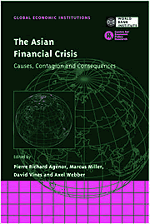Book contents
- Frontmatter
- Contents
- List of figures
- List of tables
- Preface
- List of conference participants
- Acknowledgements
- List of abbreviations and acronyms
- Introduction
- Part One General Accounts
- Part Two Theoretical Contributions
- Part Three Contagion
- 8 Contagion: monsoonal effects, spillovers and jumps between multiple equilibria
- Discussion
- 9 Contagion and trade: why are currency crises regional?
- Discussion
- 10 Competition, complementarity and contagion in East Asia
- Discussion
- Part Four Policy Responses
- Index
Discussion
from Part Three - Contagion
Published online by Cambridge University Press: 26 February 2010
- Frontmatter
- Contents
- List of figures
- List of tables
- Preface
- List of conference participants
- Acknowledgements
- List of abbreviations and acronyms
- Introduction
- Part One General Accounts
- Part Two Theoretical Contributions
- Part Three Contagion
- 8 Contagion: monsoonal effects, spillovers and jumps between multiple equilibria
- Discussion
- 9 Contagion and trade: why are currency crises regional?
- Discussion
- 10 Competition, complementarity and contagion in East Asia
- Discussion
- Part Four Policy Responses
- Index
Summary
Chapter 10 is about the role of trade linkages in the Asian crisis. The authors argue that a proper understanding of these linkages is essential for an adequate understanding of the crisis. In doing so, they draw attention to the importance of differences between countries, and they note that much existing analysis of the crisis is unsatisfactory in that it has treated countries as if they were essentially similar. Their central idea is that the impact of events in one country on outcomes in an another will differ, depending on whether the countries in question have complementary or competitive trade structures.
The chapter deals with two distinct aspects of the Asian crisis. First it describes the way in which the onset of the crisis would be expected to be different for competitors and complementary countries. It then goes on to examine how contagion might have occurred between the different groups. Our comments are addressed mainly to the first issue. At the end of our comments we offer some rather brief remarks on the second.
In describing the onset of the crisis, and ascribing causes, the chapter first sets out a trade-competition story which describes the situation for countries producing in the same market segments, with high export concentration and similar export share structures. In such a story, an external shock, such as China's devaluation in 1994, affects all such countries similarly. A higher rate of Chinese growth would also increase competition in export markets and so would also have negative effects on them.
- Type
- Chapter
- Information
- The Asian Financial CrisisCauses, Contagion and Consequences, pp. 348 - 354Publisher: Cambridge University PressPrint publication year: 1999



